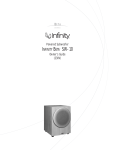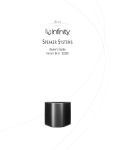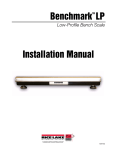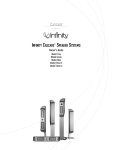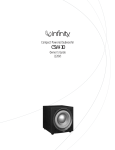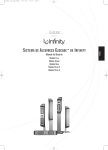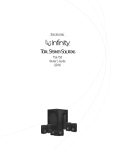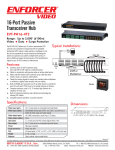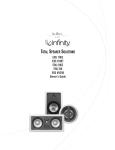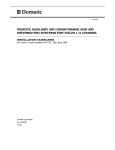Download Infinity 2100m Speaker System User Manual
Transcript
® M A R I N E ¨ off auto on 6100m, 6000m, 2100m wakeboard tower sound system instructions Thank you Infinity would like to take this opportunity to thank you for purchasing one of our products. In order that we may better serve you should you require warranty service, please retain your original purchase receipt. If you would like to register your product, please visit our Web site at www.infinitysystems.com. INTRODUCTION INSTALLATION WARNINGS DESCRIPTION CLEANING AND PRECAUTIONS WARNING! Loud music can cause permanent damage to your hearing. We recommend listening to your system at moderate volume levels while driving your boat. Infinity accepts no liabilities for hearing loss, bodily harm or property damage resulting from the use or misuse of our products. • Always wear protective eyewear when using tools. • The 6000m Wakeboard Tower Speakers are constructed of weatherproof cast-polymer, and have passed our most stringent tests to ensure that you get only the best quality product. The 6100m uses two active 6-1/2" polypropylene speakers with a 1" CMMD™ tweeter. The cast-aluminum mounting brackets are adjustable to fit almost any commonly available tube (1-1/2" to 2-1/2") and can be configured for surface mounting. Although the 6000m speaker pods are waterand salt-spray-resistant, keep in mind that the speakers are exposed and may be damaged during washdowns. Use only a damp cloth to wipe the speakers down. DO NOT spray water, or any liquids, directly at the speakers. High pressure may damage the speakers, especially the tweeters. The 6100m and 2100m amplifiers should be installed where they will not come in contact with water or other liquids. The amplifier could be damaged during washdowns. IMPORTANT To get the best performance from your Infinity Marine Audio products, we strongly recommend that installation be entrusted to a qualified professional. Although these instructions explain how to install the Wakeboard Tower System in a general sense, they do not show specific installation methods that may be required for your particular application. If you do not have the necessary tools or experience, do not attempt the installation yourself. Instead, please ask your authorized Infinity car/marine audio dealer about professional installation. • Turn off the audio system and other electrical devices before you start. Disconnect the (–) negative lead from your boat’s battery and/or turn off the battery switch if you have a multiple battery setup. • Check clearances on both sides of a planned mounting surface before drilling any holes or installing any screws. Remember that the screws can extend behind the surface and could puncture the boat’s hull. • At the installation sites, locate and make a note of all fuel lines, steering cables, and electrical wiring. Use extreme caution when cutting or drilling in and around these areas. • Before drilling or cutting holes, use a utility knife to remove unwanted fabric or vinyl to keep material from snagging in a drill bit or mounting screws. • When routing cables, keep input-signal cables away from power cables and speaker wires. • When making connections, make certain they are secure and properly insulated. 2 • The 6100m Wakeboard Tower System is an all-in-one speaker system for your boat. The 6100m includes two all-weather speaker pods (6000m) with all of the mounting hardware, and a dedicated 2-channel amplifier with an integrated microphone and controls. This system allows you to listen to music while riding, and allows the driver to communicate back to the rider. • The 2100m Marine Amplifier is a stand-alone amplifier that can be used with or without the 6100m system. This amplifier can be used to supply power to interior speakers or additional 6000m wakeboard tower speakers. MOUNTING THE 6000M SPEAKERS The 6000m speakers use a unique mounting bracket that works with various tube sizes and flat mounting surfaces. The speakers also incorporate a swivel feature that allows you to easily turn them once they’re mounted. TUBE-MOUNTING The 6000m speakers can accommodate tower tubes that range from 1-1/2" to 2-1/2" in diameter. The top of the mounting bracket is made with two cutouts that allow the bracket to easily adjust to the tower. Simply rotate the bracket 90 degrees, depending on your application. Position the bottom bracket with the speaker and top bracket in place on the tower. Install the supplied 2-1/2" bolts through the top bracket and tighten in place using a 5mm hex-key wrench. While tightening the bolts, keep the bottom bracket parallel with the top bracket at all four corners of the bracket. Take care not to overtighten the bracket. See Figure 1. Once the speakers are in position, install the set screws in the bottom of the bracket to keep the speakers from twisting out of place. See Figure 2. NOTE: There are four pre-tapped mounting holes (1/4-20 thread) on the top of each speaker bracket that can be used for mounting accessories, such as lighting. See Figure 3. CONNECTING THE SPEAKERS SURFACE-MOUNTING Some towers may have a flat support panel used to mount accessories such as lighting, board holders, radars, antennas or other accessories. If you wish to mount the 6000m speakers to this panel, use the 2-1/2" screws to clamp the bracket together, as shown in Figure 3. Using the four mounting holes in the top of the bracket, align the speaker with holes on the mounting plate on the tower. If there are no holes in the panel, use the bracket as a template to mark the locations of the four holes. Drill four new holes in the panel. DO NOT drill through the holes in the bracket. Insert the 1-1/4" bolts using the large washers and tighten using a 5mm hex-key wrench. SWIVELING THE SPEAKERS Located at the base of the speaker mounting bracket is a swivel-lock pin. Pull this pin up in order to swivel the speaker 270 degrees at 45-degree intervals. Once you have the speaker near the position that you want, release the pin and rotate the speaker until the pin locks in place. Connect the speakers to an amplifier using the supplied speaker wires. The weatherproof connectors allow for quick connection and disconnection of the wires when installing and removing the speakers. Figure 4. Pulling the swivel-lock pin up. Run the wires along the tube and secure in place with plastic zip ties. If the tube has wire holes available, run the speaker wires through the tower tubes to the amplifier. Check to make sure the wires will not come in contact with sharp edges or metal that can damage the wires over time. NOTE: The white-striped wire is the positive connection. NOTE: The connectors are keyed to line up properly. Check for proper alignment before connecting. Figure 3. Surface-mounting. Figure 6. Key notch. Figure 5. Swiveling the speaker. Figure 1. Clamping the brackets down. Figure 2. Installing the set screws. 3 MOUNTING THE AMPLIFIER Mount the 6100m or 2100m amplifier in a location that is away from direct contact with water, whether from washing, big waves or soggy riders. Choose a location in the boat where the amplifier will not be damaged by shifting cargo or passengers. If the amplifier is going to be under a seat, ensure that it is clear of all moving parts and will not affect the seat adjustments. If mounting the amplifier in an enclosed space, make sure there is plenty of air circulation for the amplifier to cool properly. POWER CONNECTIONS The 6100m/2100m amplifiers are capable of delivering high power levels, and require a reliable connection to the boat’s electrical system in order to perform optimally. See Figure 8 for terminal location. Please adhere to the following instructions carefully: GND TERMINAL Connect the amplifier’s Ground (GND) terminal directly to the boat’s negative (–) battery terminal using a minimum of 8-gauge power wire. +12V TERMINAL Connect a minimum of 8-gauge power wire directly to the boat’s positive battery terminal, and install an appropriate fuse holder within 18" of the battery terminal. Do not install the fuse at this time. Route the wire to the amplifier’s location, and connect it to the amplifier’s positive (+12V) terminal. Be sure to use appropriate grommets whenever routing wires through panels. Failure to adequately protect the positive wire from potential damage may result in a fire. When you are done routing and connecting this wire, you may install the fuse at the battery. CONTROLS AND SETTINGS NOTE: When using the Hi-level inputs, connect the REMOTE terminal to the source unit. Setting the controls on the 6100m amplifier or 2100m amplifier. REMOTE OUT If using additional amplifiers and tower speakers connect the REMOTE OUT terminal using a 1/4" spade connection to the Remote input terminal of the other amplifier. The REMOTE OUT works in conjuction with the Power switch on the microphone (please refer to page 5). SETTING THE GAIN 1. Start with the GAIN control set to minimum (counterclockwise) and set the music level on the microphone to maximum (clockwise). LINE IN Connect to the source unit’s line-level output using RCA cables. LINE OUT Can be used to pass signal from the Line In to additional amplifiers. Also has the option to pass paging information (refer to Page Ext switch). SPEAKER CONNECTIONS Refer to the application guides on the pages that follow. Speaker connections should be made using the supplied speaker wires. If additional wire is necessary, use a minimum of 16 awg. speaker wire. Minimum speaker impedances: 6100m amplifier 4 ohms, stereo 2100m amplifer 2 ohms, stereo/4 ohms, bridged PAGE EXT SWITCH When set to the ON position, the Page Ext switch will allow the PA signal to pass through to another amplifier when using the Line Out outputs on the 6100m amplifier. Set to OFF if you do not want the PA signal to pass through to another amplifier and speakers. 2. Reconnect the negative (–) lead to the boat’s battery. Apply power to the audio system and play a dynamic music track. 3. On the source unit, increase the volume control to 3/4 volume. Slowly increase the GAIN control until you hear slight distortion in the music. Then reduce the GAIN control slightly until distortion is no longer heard. Figure 8. End plates. REMOTE OUT 6100m R L HI-LEVEL INPUT CONNECTIONS The 6100m and 2100m amplifiers are equipped with speaker-level inputs that allow you to add an amplifier to head units that do not have RCA line outputs. The speaker outputs for the source unit should be connected to the amplifier using the supplied connector (square four-wire plug). Remember to check for proper polarity. Figure 7. Speaker-level connector. NOTE: If your boat uses a multiple battery setup, please contact the boat manufacturer or dealer for proper connection instructions. REMOTE TERMINAL Connect the amplifier’s REMOTE terminal to the source unit’s Remote Turn-On lead, using a minimum of 18-gauge wire. If your source unit does not have a remote turn-on connection, connect the amplifier’s REMOTE terminal to the boat’s accessory circuit. 4 2100m HIGH LEVEL INPUT + R – + L – GRAY + GRAY/BLACK – – WHITE/BLACK + WHITE L R Speaker Wires (spliced) NOTE: When using the Hi-level inputs, the Line Out on the 6100m can be used to pass a full-range line-level signal to another amplifier. 2100m 6100M MICROPHONE MOUNTING THE MICROPHONE CONNECTOR PLATE Locate a suitable place for the microphone plate to be installed. (Make sure that there are no wires or control lines behind this surface.) Mark the four screw locations. Draw an “X” between the mounting screw locations. MICROPHONE OPERATION MOUNTING THE MICROPHONE HOLDER Locate a position to secure the microphone holder and mark screw hole positions. NOTE: This location should be within reach of the driver but should not hinder any of the normal operations of the boat or safety equipment (lights, steering, throttle control, etc.). Predrill the holes. Using a 7/8" holesaw, drill a hole in the center of the “X” to allow the microphone cable to be passed through. Pre-drill the mounting screw locations. Route the microphone cable from the amplifier to the plate mounting location. Using three of the supplied screws, mount the holder. Align the ring on the back of the microphone with the holder and slide in a downward motion. The microphone will click into the holder. Figure 10. Mounting the microphone holder. Pass the cable through the hole and secure to the plate using the supplied lock ring and ring tool. Position the assembled plate over the mounting hole and secure, using the supplied screws. Connect the microphone and install the weather-resistant cover. Figure 9. Mounting the connector plate. POWER SWITCH OFF – Turns the 6100 system off. Figure 11. Microphone. AUTO – Allows the 6100m system to operate in conjunction with the REMOTE trigger from your head unit. ON – Turns the 6100m system ON; allows the PA feature to be used without having to turn the audio system on. NOTE: When you’ve finished using the system, make sure the Power switch is placed in the AUTO or OFF position. If the system is left in the ON position for an extended period of time, it may deplete the battery. CONTROLS Music level – Adjusts the volume of the music that is played through the 6100m system. Page level – Adjusts the volume level of the paging system. OPERATIONS AND WARNINGS To operate the microphone, push in and hold the MIC button while speaking. Release the button once you are finished. Hold the microphone approximately 3– 6 inches from your mouth. Refrain from shouting into the microphone; this can cause distortion at higher volumes. If you hear feedback (squeal) while using the Page system, move the microphone away from your mouth and/or reduce the page level. 5 APPLICATIONS Figure 13. 6100m System line-level connection. Figure 12. 6100m System speaker-level connection. Remote Turn-On Splices (not supplied) L Speaker 6 LF Speaker Source Unit Splices (not supplied) Remote Turn-On RF Speaker Source Unit R Speaker LR Speaker RR Speaker APPLICATIONS Figure 14. 6100m System with a 2100m amplifier powering internal boat speakers. Figure 15. 6100m System with a 2100m amplifier and 6000m speakers. PAGE EXT ON PAGE EXT OFF 6100m 2100m ON OFF OR 6100m 2100m Remote Turn-On Remote Out LF Speaker Remote Turn-On RF Speaker Source Unit Source Unit LR Speaker NOTE: If the 6100m is turned off using the Power switch, there is no signal pass-through on the LINE OUT connections. RR Speaker NOTE: Match the gain of the output of the two speaker sets so they perform at the same volume level. 7 TROUBLESHOOTING SPECIFICATIONS • PROBLEM: No audio (POWER LEDs are off). CAUSES and SOLUTIONS: 1. No voltage at Batt + or remote terminal. – Check all power connections with a VOM. 2. Poor ground connection. – Check fuses. 3. Microphone power switch is off. – Check power switch on Mic. • PROBLEM: No audio (POWER LEDs are on). CAUSE and SOLUTIONS: 1. No input signal or no speaker signal. – Check all input connections from source unit. – Check all speaker connections. – Check fader control on head unit. • PROBLEM: No audio (blue LED on – red LED flashing).** CAUSES and SOLUTIONS: 1. Over or under voltage. – Battery voltage above 16 volts or below 10 volts. Check battery and charging system for proper operation. 2. Shorted output. – Check speaker connections and wires. • PROBLEM: No audio (blue LED off, red LED flashing).** CAUSE and SOLUTION: 1. Thermal protection. – Turn the system off and allow the amplifier to cool off. • PROBLEM: Distorted audio (blue LED on, red LED off). CAUSES and SOLUTIONS: 1. Gain control is set too high, or amplifier or source unit is defective. – Check gain setting. – Source unit output is distorted. 2. Short circuit in speaker wires. – Check speaker wires for shorts or grounds. • PROBLEM: Music lacks punch. CAUSE and SOLUTION: 1. Speakers are not connected properly. – Check speaker connections for proper polarity. ** NOTE: The microphone has a blue power LED and the amplifier has a red power LED. Features, specifications and appearance are subject to change without notice. Infinity Systems, 250 Crossways Park Drive, Woodbury, NY 11797 USA 516.674.4INF (4463) • FAX 516.682.3556 • www.infinitysystems.com © 2004 Harman International Industries, Incorporated Infinity is a registered trademark, and CMMD is a trademark, of Harman International Industries, Incorporated. CMMD patent nos. 6,327,372 and 6,404,897. Part No. 6100MOM6/04 • Printed 6/04 • PROBLEM: No audio from page. CAUSES and SOLUTIONS: 1. Microphone is not connected properly. – Check microphone connections. 2. Page level set to minimum. – Check level control on microphone. • PROBLEM: Page is distorted. CAUSES and SOLUTIONS: 1. Page level is too high. – Reduce page level. 2. Shouting into microphone. – Hold microphone away from face. • PROBLEM: Feedback. CAUSES and SOLUTIONS: 1. Squealing sound from the speakers when using the Paging system. – Reduce page level on microphone. – Increase distance between microphone and mouth while speaking. 6100m • 125W x 2 ch. • Frequency Response: 10Hz – 40kHz • Signal-to-Noise Ratio: 91dB • Line-Level Input Sensitivity: 250mV – 6V • Speaker-Level Input Sensitivity: 6V – 16V • Speakers: 11" x 18" x 14-1/2" • Amplifier: 8-1/8" x 8" x 2-3/8" • Microphone: 1-1/4" x 2-1/2" x 3-5/8" • Min. Speaker Impedance: 4 ohms, stereo 6000m • Power Handling: 150W • Peak Power Handling: 450W • Sensitivity: 93dB @ 2.83V • Frequency Response: 80Hz – 20kHz • Impedance: 4 ohms • Polypropylene Cone • Cast-Polymer Basket • CMMD™ Tweeter • Rubber Surrounds • UV-Resistant • Water-Resistant • Salt-Spray-Resistant • 11" x 18" x 14-1/2" 2100m • 125W x 2 ch. @ 4 ohms • 150W x 2 ch. @ 2 ohms • 250W x 1 ch. @ 4 ohms • Frequency Response: 10Hz – 40kHz • Signal-to-Noise Ratio: 91dB • Line-Level Input Sensitivity: 250mV – 6V • Speaker-Level Input Sensitivity: 6V – 16V • 8-1/8" x 8" x 2-3/8" • Min. Speaker Impedance: 2 ohms, stereo 4 ohms, bridged









